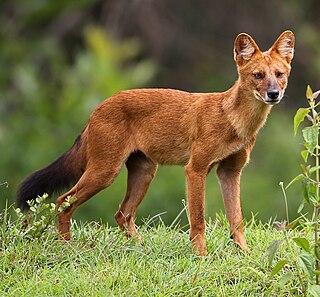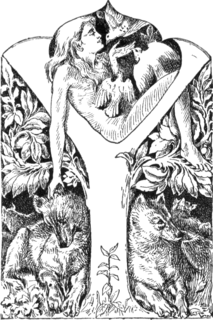
The coyote is a canine native to North America. It is smaller than its close relative, the gray wolf, and slightly smaller than the closely related eastern wolf and red wolf. It fills much of the same ecological niche as the golden jackal does in Eurasia, though it is larger and more predatory, and is sometimes called the American jackal by zoologists. Other names for the species, largely historical, include prairie wolf and brush wolf.

The dhole is a canid native to Central, South, East Asia, and Southeast Asia. Other English names for the species include Asian wild dog, Asiatic wild dog, Indian wild dog, whistling dog, red dog, and mountain wolf. It is genetically close to species within the genus Canis, but distinct in several anatomical aspects: its skull is convex rather than concave in profile, it lacks a third lower molar and the upper molars sport only a single cusp as opposed to between two and four. During the Pleistocene, the dhole ranged throughout Asia, Europe, and North America but became restricted to its historical range 12,000–18,000 years ago.

The wolf, also known as the gray wolf or grey wolf, is a large canine native to Eurasia and North America. It is the largest extant member of Canidae, with males averaging 40 kg (88 lb) and females 37 kg (82 lb). On average, wolves measure 105–160 cm (41–63 in) in length and 80–85 cm (31–33 in) at shoulder height. The wolf is also distinguished from other Canis species by its less pointed ears and muzzle, as well as a shorter torso and a longer tail. The wolf is nonetheless related closely enough to smaller Canis species, such as the coyote and the golden jackal, to produce fertile hybrids with them. The fur of a wolf is usually mottled white, brown, gray, black, and banded. Up to 38 subspecies of wolf have been recognized including the domestic dog.

A wolfdog is a canine produced by the mating of a domestic dog with a gray wolf, eastern timber wolf, red wolf, or Ethiopian wolf to produce a hybrid.

Shere Khan is a fictional Bengal tiger and the main antagonist of Rudyard Kipling's Jungle Book and its adaptations. His name is a translation of the English denomination of the bengal tiger: "Royal Tiger" into the Hindi language, where "shere" means "tiger" and "khan" is the mongol word for "king" and the name of the Indian Moghul ruler family. According to The Kipling Society, the word shere translates as "tiger", and khan is a title of distinction, used together "to show that he is chief among tigers." Other sources indicate Shere may mean "tiger" or "lion" in Azerbaijani, Persian, Kurdish, Hindustani, and Punjabi, and that khan translates as "king", or "leader", in a number of languages influenced by the Mongols, including Pashto and Hindustani.

The striped hyena is a species of hyena native to North and East Africa, the Middle East, the Caucasus, Central Asia and the Indian subcontinent. It is listed by the IUCN as near-threatened, as the global population is estimated to be under 10,000 mature individuals which continues to experience deliberate and incidental persecution along with a decrease in its prey base such that it may come close to meeting a continuing decline of 10% over the next three generations.

The golden jackal is a wolf-like canid that is native to Southeast Europe, Southwest Asia, South Asia, and regions of Southeast Asia. Compared with the Arabian wolf, which is the smallest of the gray wolves, the jackal is smaller and possesses shorter legs, a shorter tail, a more elongated torso, a less-prominent forehead, and a narrower and more pointed muzzle. The golden jackal's coat can vary in color from a pale creamy yellow in summer to a dark tawny beige in winter. It is listed as Least Concern on the IUCN Red List due to its widespread distribution and high density in areas with plenty of available food and optimum shelter.

Wolf hunting is the practice of hunting gray wolves (Canis lupus) or other species of wolves. Wolves are mainly hunted for sport, for their skins, to protect livestock and, in some rare cases, to protect humans. Wolves have been actively hunted since 8,000 to 10,000 years ago, when they first began to pose a threat to livestock vital for the survival of Neolithic human communities. Historically, the hunting of wolves was a huge capital- and manpower-intensive operation. The threat wolves posed to both livestock and people was considered significant enough to warrant the conscription of whole villages under threat of punishment, despite the disruption of economic activities and reduced taxes. The hunting of gray wolves, while originally actively endorsed in many countries, has become a controversial issue in some nations. Opponents see it as cruel, unnecessary and based on misconceptions, while proponents argue that it is vital for the conservation of game herds and as pest control.

The Indian wolf is a subspecies of grey wolf that ranges from Southwest Asia to the Indian Subcontinent. It is intermediate in size between the Tibetan and Arabian wolf, and lacks the former's luxuriant winter coat due to it living in warmer conditions. Two closely related haplotypes within this subspecies have been found basal to all other extant Canis lupus haplotypes apart from the older-lineage Himalayan wolf, and have been proposed as a separate species. The Indian wolf travels in smaller packs and is less vocal than other variants of the grey wolf, and has a reputation for being cunning.

Wolf attacks are injuries to humans or their property by any subspecies of wolf. Their frequency varies with geographical location and historical period. Gray wolf attacks are rare because wolves are often subsequently killed, or even extirpated in reaction by human beings. As a result, wolves today tend to live mostly far from people or have developed the tendency and ability to avoid them. The country with the most extensive historical records is France, where nearly 7,600 fatal attacks were documented from 1200 to 1920. There are few historical records or modern cases of wolf attacks in North America. In the half-century up to 2002, there were eight fatal attacks in Europe and Russia, three in North America, and more than 200 in south Asia. Experts categorize wolf attacks into various types, including rabies-infected, predatory, agonistic, and defensive.
Man-eater is a colloquial term for an individual animal that preys on humans as a pattern of hunting behavior. This does not include the scavenging of corpses, a single attack born of opportunity or desperate hunger, or the incidental eating of a human that the animal has killed in self-defense. However, all three cases may habituate an animal to eating human flesh or to attacking humans, and may foster the development of man-eating behavior.
The Wolves of Ashta were a pack of 6 man-eating Indian wolves which between the last quarter of 1985 to January 1986, killed 17 children in Ashta, Madhya Pradesh, a town in the Sehore district. The pack consisted of two adult males, one adult female, one subadult female and two pups. Initially thought to be a lone animal, the fear caused by the wolves had serious repercussions on the life of the villagers within their hunting range. Farmers became too frightened to leave their huts, leaving crops out of cultivation, and several parents prohibited their children from attending school, for fear that the man-eaters would catch them on the way. So great was their fear, that some village elders doubted the man-eaters were truly wolves at all, but Shaitans. With the exception of the pups, which were adopted by Pardhi tribesmen, all wolves were killed by hunters and forest officials.
The Wolf of Gysinge was a man-eating wolf which, in three months, attacked and killed many children in Gysinge near central Sweden in the early 1820s.

A feral child is a human child who has lived isolated from human contact from a very young age, and so has had little or no experience of human care, behavior or human language. There are several confirmed cases and other speculative ones. Feral children may have experienced severe abuse or trauma before being abandoned or running away. They are sometimes the subjects of folklore and legends, typically portrayed as having been raised by animals.

A black wolf is a melanistic colour variant of the gray wolf. Black specimens are recorded among red wolves, and these colour variants are probably still around today. Genetic research from the Stanford University School of Medicine and the University of California, Los Angeles revealed that wolves with black pelts owe their distinctive coloration to a mutation which occurred in domestic dogs, and was carried to wolves through wolf-dog hybridization. Besides coat and knee colour, they are normal grey wolves.

Wolves are sometimes kept as exotic pets, and in some rarer occasions, as working animals. Although closely related to domesticated dogs, wolves do not show the same tractability as dogs in living alongside humans, and generally, a greater amount of effort is required in order to obtain the same amount of reliability. Wolves also need much more space than dogs, about 25 to 40 square kilometres so they can exercise.
The Kirov wolf attacks were a series of man-eating wolf attacks on humans which occurred in 1944–1954 in nine raions (districts) of the 120,800 km2 Kirov Oblast of the Russian Soviet Federative Socialist Republic which resulted in the deaths of 22 children and teenagers between the ages of 3 and 17. In all cases, the attacks occurred in the April to December period, coinciding with the wolf's cubbing season.

The city of Moscow, Russia hosts a large population of free-ranging dogs. Many operate in packs and have become accustomed to seeking food from passersby. Some of them who frequent or inhabit the subway have attracted international attention for learning how to use the trains to commute between various locations.

The African golden wolf, also known as the Egyptian jackal or gray jackal, is a canid native to North Africa and the Horn of Africa. It is the descendant of a genetically admixed canid of 72% gray wolf and 28% Ethiopian wolf ancestry. It occurs in Senegal Nigeria, Chad, Morocco, Algeria, Tunisia, Libya and Egypt, and in Tanzania. It is listed as Least Concern on the IUCN Red List. In the Atlas Mountains, it was sighted in elevations as high as 1,800 m (5,900 ft). It is primarily a predator, targeting invertebrates and mammals as large as gazelle fawns, though larger animals are sometimes taken. Its diet also includes animal carcasses, human refuse, and fruit. The African golden wolf is a monogamous and territorial species, offspring remain with the family to assist in raising their parents' younger pups.














